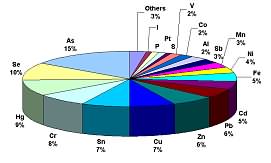Depending on the area of interest, elemental speciation analysis is focussing on chemical compounds that differ in isotopic composition, conformation, oxidation or electronic state, or in the nature of their complexed or covalently bound substituents, all being regarded as distinct chemical species. Often the following groups of species are differentiated:
- Valency species such as As(III)/As(V), Cr(III)/Cr(VI), Se(IV)/Se(VI)
- Inorganic compounds and complexes such as NiSO4/NiCl2 and aluminium-hydroxo complexes
- Alkyl-or Arylelement species such as methylmercury, ethyllead, butyltin, triphenyltin
- High molecular mass compounds such as metalloproteins, metalloporphyrines.
 With respect to the elements, speciation analysis is focusing actually on the transition metals (such as Cr, Ni, Cu, Pt, Hg), metals (such as Al, Sn, Sb, Pb) and metalloids (such as As, Se). However in a broader sense, also nonmetals (such as P, S) and halogens (I, Br) are of interest. Since most studies are related to concerns about human health risks, an important number of publications is focusing on only few toxic element species. As can be seen from the distribution of elements in studies published 2000-2005, 50% of all papers are dealing with only 5 elements, namely arsenic, selenium, mercury, chromium and tin. Another 30 % of papers are dealing with copper, zinc, lead, cadmium and iron. All other elements in total are in the focus of only 20% of the publications.
With respect to the elements, speciation analysis is focusing actually on the transition metals (such as Cr, Ni, Cu, Pt, Hg), metals (such as Al, Sn, Sb, Pb) and metalloids (such as As, Se). However in a broader sense, also nonmetals (such as P, S) and halogens (I, Br) are of interest. Since most studies are related to concerns about human health risks, an important number of publications is focusing on only few toxic element species. As can be seen from the distribution of elements in studies published 2000-2005, 50% of all papers are dealing with only 5 elements, namely arsenic, selenium, mercury, chromium and tin. Another 30 % of papers are dealing with copper, zinc, lead, cadmium and iron. All other elements in total are in the focus of only 20% of the publications.
 Further chapters: About Speciation
Further chapters: About Speciation
last time modified: June 15, 2020